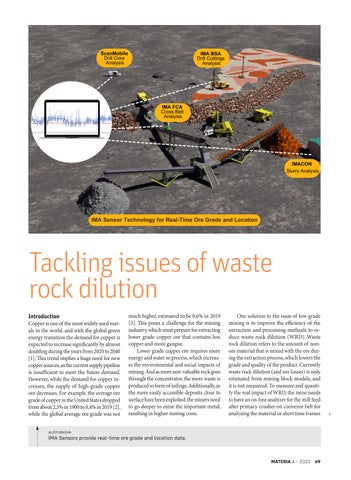Tackling issues of waste rock dilution Introduction Copper is one of the most widely used metals in the world, and with the global green energy transition the demand for copper is expected to increase significantly by almost doubling during the years from 2020 to 2040 [1]. This trend implies a huge need for new copper sources, as the current supply pipeline is insufficient to meet the future demand. However, while the demand for copper increases, the supply of high-grade copper ore decreases. For example, the average ore grade of copper in the United States dropped from about 2,5% in 1900 to 0,4% in 2019 [2], while the global average ore grade was not
much higher, estimated to be 0,6% in 2019 [3]. This poses a challenge for the mining industry, which must prepare for extracting lower grade copper ore that contains less copper and more gangue. Lower grade copper ore requires more energy and water to process, which increases the environmental and social impacts of mining. And as more non-valuable rock goes through the concentrator, the more waste is produced in form of tailings. Additionally, as the more easily accessible deposits close to surface have been exploited, the miners need to go deeper to mine the important metal, resulting in higher mining costs.
One solution to the issue of low-grade mining is to improve the efficiency of the extraction and processing methods to reduce waste rock dilution (WRD). Waste rock dilution refers to the amount of nonore material that is mixed with the ore during the extraction process, which lowers the grade and quality of the product. Currently waste rock dilution (and ore losses) is only estimated from mining block models, and it is not measured. To measure and quantify the real impact of WRD, the mine needs to have an on-line analyzer for the mill feed after primary crusher on conveyor belt for analyzing the material in short time frames
ALOITUSKUVA
IMA Sensors provide real-time ore grade and location data.
MATERIA 4 – 2023 69
>


























